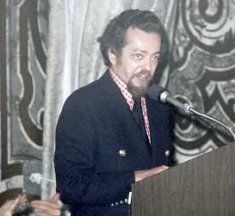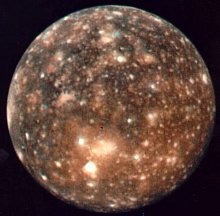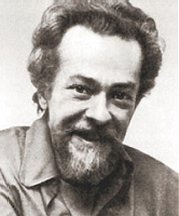Before I begin, I’d like to acknowledge Steve Servello, another fan
of Zanthodon, whose thoughts and writings were helpful to me in developing
this essay. I freely admit to borrowing here and there at points
from Steve, and to using some of his ideas, either on their own or as starting
points. Steve has done a map of Zanthodon, which I hope we’ll see
accompanying these essays. But, on to business...
In 1922, Edgar Rice Burroughs, drawing on both Jules Verne’s Journey
to the Centre of the Earth, and Conan Doyle’s Lost World, and
making free use of Marshall Gardner’s wacky theories of a hollow world,
created Pellucidar. A strange world on the inside of our hollow
world, peopled by dinosaurs and cavemen. Starting with At
the Earth’s Core Burroughs published seven Pellucidar novels over a
twenty-two year period, ending in 19444
Lin Carter, an occasionally fictional character (see Lankar of Callisto),
chronicled the adventures of Eric Carstairs in a series of five books,
published between set in an underground lost world called Zanthodon
between 1979 and 1982.
Zanthodon has a more than passing resemblance to Edgar Rice Burroughs
creation of Pellucidar.
Did I say ‘passing resemblance’?
Zanthodon is pretty much a straight lift of Pellucidar, in just about
every way conceivable short of calling the place Radicullep.
In this essay, we’re going to explore both the literary and the literal
relationship of Zanthodon to Pellucidar.
Why should we bother? Well, partly I suppose because its
fun. Partly because if you’re a fan of the Pellucidar books you should
really go out and collect the Zanthodon books. The Zanthodon
books are a perfect replica of the Pellucidar series, they capture the
feel and style perfectly. More than that, they Zanthodon books fit
neatly together, amounting to a much larger and more unified work.
Zanthodon is essentially Pellucidar’s version of War and Peace.
Well first, we have to acknowledge that Carter was well aware of Burroughs
Pellucidar when he created his own underground world. The first
step is always to establish some connection. Obviously, Zanthodon
can’t derive from Pellucidar if Carter never heard of the place.
So its comforting to note Burroughs underground world is actually referenced
by the characters themselves. In the first chapters, Carter’s
character refers to Burroughs, Verne and Doyle.
It is also remarkable how closely and in how many ways the Zanthodon
series resembles Pellucidar.
Of course, both books feature a pair of intrepid explorers who make
their way into a vast underground world peopled by dinosaurs and cavemen,
so resemblances are inevitable.
But when we look at Zanthodon, we see the same characters.
Eric Carstairs is a young heroic, adventurous man, much like David Innes.
Of course, that’s pretty generic. We’ve got a standard young hero
here.
On the other hand, Professor Potter of Zanthodon is pretty much a clone
of Abner Perry of Pellucidar. Both of these are ‘out of touch’ geniuses.
Both men are elderly but brilliant polymaths, well versed in a number of
esoteric unrelated fields. Both, for instance, invent firearms in
their underground world. Both are frail old guys with surprising
resilience. Both are essentially comic relief characters, whose antics
occasionally move the plot, but who also betray reserves of moral strength
and physical resourcefulness.
Now arguably, the befuddled elderly super scientist is a stock character
these days. Perhaps not so much so in the early days of Burroughs
Pellucidar. But still, the resemblances between Perry and Potter,
extending even to their names, seems more than coincidental. One
person is clearly patterned on the other. And the Carstairs/Potter
dynamic is just as clearly modeled on the Innes/Perrry relationship.
Then there are the various cavemen personas, Chiefs, Princesses and
heroic warriors, who loosely correspond to similar persons in the Pellucidar
stories. Like Burroughs in Pellucidar, Carter in Zanthodon
takes the unusual step of allowing his cavemen to be heroes and adventurers
in their own right. This is a remarkable step, because, of course,
initially we have to tie the audience identification to western European/Americans
like ourselves. In both cases, there’s a certain confidence involved
in showing protagonists who are non-American primitives.
There are parallel situations and events. Most notably,
there are the Sluaghs and Gorpoks. In Zanthodon, the Sluaghs are
gigantic five foot long slugs or leeches with six eyes and hypnotic abilities.
Carter states that they’re intelligent, but there’s no specific evidence
of this. Rather, the Sluaghs rule a cave city, where their henchmen,
the semi-human Gorpoks rule and abuse a population of human slaves, some
of whom are fed to their masters.
The Sluaghs are clear parallels to the Mahars, intelligent inhuman pterodactyls
with their own hypnotic abilities. Like the Sluaghs, the Mahars
rule their own city, where their henchmen, the apelike Sagoths rule and
abuse a population of human slaves, some of whom are fed to their masters.
Basically, both series have a repellent non-human race with hypnotic powers,
and semi-human henchmen, praying on humans.
There are also the Corsairs of Pellucidar, westernized pirates who have
relocated to the underground world, maintaining an anomalously advanced,
but still archaic culture. Zanthodon answers with its Barbary
Pirates.
There is nothing quite like the Empire of Zar in Pellucidar, but Tarzan
and other pulp writers have a multitude of lost cities. Meanwhile,
Zar has its domesticated dinosaurs and dinosaur worship, as do some among
Tarzan’s Pal-Ul-Don, and the sauropod riding Lidi.
Pellucidar gives us the German, Von Horst as a protagonist. Meanwhile,
Zanthodon provides us with a lost troop of friendly WWII Germans.
And there appear to be deliberately borrowed traits, such as the distortions
of time, the ‘homing sense.’ In short, the Zanthodon series is full
of little bits and pieces, odds and ends, scenes and notions which appear
quite close to Pellucidar.
This similarity also appears in the titling. Here are the
titles of the two respective series:
| BURROUGHS |
CARTER |
| At the Earth’s Core |
Journey to the Underground World |
| Pellucidar |
Zanthodon |
| Tanar of Pellucidar |
Hurok of the Stone Age |
| Tarzan at the Earth’s Core |
Darya of the Bronze Age |
| Back to the Stone Age |
Eric Carstairs of Zanthodon |
| Land of Terror |
Savage Pellucidar |
Notice both series first books refer to the underworld by description.
Both of the second books refer to the underworld by its name.
The third and fourth books refer to savage or ‘primitive’ individuals,
Tanar and Tarzan, and Hurok and Darya, respectively. Back to the
Stone Age is also paralleled by Hurok of the Stone Age, while
Tarzan
at the Earth’s Core is also paralleled by Eric Carstairs of Zanthodon,
both referring to outsiders to the underworld. The final books
in each series Savage Pellucidar and Eric Carstairs of Zanthodon
again repeat the name of the Underworlds. So the similarities
in titles and sequence of titles seems to be deliberate.
At the bottom of it all, the style of both series is literally identical.
Burroughs' Pellucidar series was probably the lightest and the loosest
of his novels. Perhaps this was because the premise was so
inherently ridiculous, or perhaps because in some ways, it was pitched
to an arguably younger audience more attuned to the fantastic.
Whatever the case, there’s something lighthearted to the Pellucidar
series, a tendency to wink at the audience. The series often plays
as satire, full of role reversals and over the top characters. Up
is down, back is forth, nudity is not shocking but clothing can be obscene.
The plots are loose, at times, almost nonexistent. The trajectories
of the characters resemble a pinball machine’s lights and bells.
People just seem to bounce chaotically from one dangerous or ridiculous
situation to another, constantly joined or separated by circumstances until,
somehow at the end, it all works out well in a happy reunion.
Pellucidar is just one damned thing after another, and you never know what’s
around the next corner.
In terms of style and plot, the Zanthodon series is a perfect clone
for Pellucidar. We’ve got the same lighthearted free wheeling,
almost winking approach. Carter’s humour, while never slapstick,
veers through the series.
The sequence of events has that exact same ‘one damned thing after another’
feel to it. Indeed, I’ll confess that at one point, I envisioned
doing synopsis of each book, or of the series as a whole, as I’ve done
with the Callisto series or Otis Adelbert Kline’s books. But I had
to give it up. It’s just too chaotic, the actions to convoluted,
everything perpetually going in every direction in unpredictable ways.
Like Pellucidar, its simply a wild ride. Jump on, hang on,
and don’t worry too much.
In short, put them both up on the net, do search and replaces to mix
up a few names, and literally, you couldn’t tell one from another, or distinguish
the two series.
That said, there are some differences. One is that Carter
in Zanthodon is more willing to indulge nudity and more overt, even fetishistic
descriptions of sexuality.
There are frequent references to Darya being casual and unconcerned
with her nudity, or seeing male nudity, or even Darya attending to bodily
functions which fall just short of graphic. In other scenes,
a Gorpok again falls just short of graphic description in his rape of a
slave, while the villain Khairadine whips a naked Darya with lascivious
relish. Burroughs Pellucidar pushed the mores of its time,
obviously, cave men had a different view of nudity, skimpy wardrobes and
matrimony, but there was a limit to how far he could go. Carter
takes things a little bit further, but not so far that he loses sight.
Indeed, it works quire well, Carter’s descriptions of Zar and Zarya,
have an exotic, even erotic quality that makes the words shimmer.
In these scenes, you know you’re in the presence of a compelling strangeness.
Zarya is a barbaric Princess on the level of La or Ayesha.
It’s a quality that Carter never quite managed to bring to Callisto, and
its shame, because I think it could have pushed that series to a more enduring
greatness. Ah well...
But the big difference between Zanthodon and Pellucidar is in its scope.
The Pellucidar books are largely standalone works, one emerging directly
or indirectly out of the previous, but each largely operating on its own.
The Zanthodon books, while each eminently readable on its own actually
amount to a continuing story as such, a story that seems to expand with
each book.
The result is that the five Zanthodon books effectively amount to a
single, massive, sprawling story with an immense and rowdy cast of characters.
If Zanthodon is to be compared to Pellucidar, then we have to acknowledge
it is simply a classic Pellucidar story, no more and no less. But
what a story. Zanthodon is literally the Pellucidar epic.
Eric and the Professor go to Zanthodon, where they are enslaved by Neandertals.
There Eric falls in love with Darya and makes friends with the Neandertal
Hurok. The outworlders are menaces by the Neandertals, until
they come to the attention of a disgraced Minoan living among the cavemen.
From there, they escape, but are separated. Eric winds up with the
cro-magnons, while Darya, the Professor and a cro-magnon named Thandar
set about. Darya winds up kidnapped by the pirate, Khairadine
Redbeard, the Professor winds up among hypnotic slugs, Thandar encounters
his own jungle Princess and Eric eventually winds up in the Minoan empire
of Zar, where he meets the exotic Zarya. There’s treachery
and heroism, daring escapes, improbable coincidences, and mighty armies,
dinosaurs roar, the earth quakes, volcanoes blow up and cliff hangers populate
every other page. And just as its all chock full, Carter throws
in more characters and more plot twists. Even the villains
are deftly drawn, sometimes likeable, sometimes sympathetic.
It’s just a great story.
It’s the "War and Peace" of Pellucidar. What else can I
say, but that if you liked Pellucidar, you’ll like Zanthodon. Take
this as a recommendation for Pellucidar fans, and go out and read them.
|








